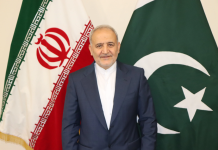Dr. Muhammad Akram Zaheer
Chinese minister of national defense Wei Fenghe visited Tehran in April and met with high profile personalities of Iran. During their visit, the Chinese envoys met with senior Iranian officials, including President Ibrahim Raisi, Chief of Staff of the Armed Forces General Staff (AFGS) Mohammad Baqeri and Defense Minister Mohammad Reza Ishtiani. Officers from the Islamic Revolutionary Guard Corps (IRGC) were also present at the meetings.
In recent years, the United States has imposed sanctions on Chinese companies exporting missile technology to Iran. In 2017, the US Treasury Department approved the sale of millions of dollars’ worth of Chinese Rowan Running Network “technology applied to navigation and guidance systems, as well as other dual-use technologies” to an Iranian Defense Ministry-affiliated entity. Washington has also fined Chinese companies who had sold Tehran jet mills which are used to make solid propellants for missiles.
Chinese companies have also supplied aluminum products used in the manufacture of centrifuges to Iran’s Centrifuge Technology Company, despite the need for permission under UN Security Council Resolution 2231. Missile and nuclear transitions could be further expanded following Resolution 2231 restrictions on Iranian exports and imports of missile-related equipment and materials under the Procurement Channel of the Missile Technology Control Regime (MTCR) and the Joint Comprehensive Plan (JCPOA).
Military cooperation is measured in ways other than solid weapons. For one thing, cyber warfare is an integral part of Iran’s arsenal, and Beijing promised to increase cyber cooperation during Foreign Minister Hussein Amir Abdullah’s visit to Wuxi in January. China is a force to be reckoned with in terms of cyber-attacks and military and industrial espionage. Countries across the region have documented high-profile cases of Chinese hackers, including widespread cyber-espionage campaigns against Israel, ongoing attacks on its defense industry, and unintentional sabotage of the medical center’s computer system.
Evidence suggests that there has been intelligence cooperation between the Chinese Foreign Ministry and its Iranian counterpart, especially between 2010 and 2012, when US intelligence networks were compromised. The maximum sharing of data and tools between the two countries, using the Comprehensive Cooperation Agreement and its cyber and intelligence sharing components as a vehicle, is something to keep in mind.
Evidence suggests that there has been intelligence cooperation between the Chinese Foreign Ministry and its Iranian counterpart, especially between 2010 and 2012, when US intelligence networks were compromised. Increased sharing of data and tools between the two countries, using the Comprehensive Cooperation Agreement and its cyber and intelligence sharing components as a vehicle, especially as relations between Beijing and Washington become more strained.
Chinese Shenhua News Agency reported that Raisi thanked Wei Fenghe for China’s long-term support and assistance in “Iran’s difficult times.” Needless to say, every dollar that flows into the Iranian treasury from Chinese banks is now secretly, but openly after the lifting of sanctions, a dollar to finance IRGC sabotage operations throughout the country.
In fact, Beijing seems to be doubling down, as a CCP spokesman points out in a recent edition of the People’s Daily, who criticized Washington for refusing to remove the IRGC from the list of foreign terrorist organizations. He claims that if the Biden administration “doesn’t pick up its list, how it can prove that the United States is ready to change its misleading maximum pressure policy on Iran?”
Clarifying how the IRGC threatens Chinese equities, Houthi rebels in Yemen are launching Iranian missiles and drones, wreaking havoc on China’s most important integrated strategic partners: Saudi Arabia and the United Arab Emirates. Iraq, China’s biggest target for the Belt and Road Initiative in 2021, with funding of 10.5 billion, has also been targeted. The latest attack took place at Saudi Aramco’s Jeddah oil depot in late March. This is the same company that was attacked in 2019, forcing China to pay an additional 97.97 million a day when Brent crude prices hit record highs.
Some scholars and experts have linked the “pro-Russian neutrality” of China and Iran to Vladimir Putin’s unilateral invasion of Ukraine, a joint insult by the three countries to the US-led Western international system, a new “axis of evil”. Other recent events, such as Wei Feng’s visit, Iran’s entry into the Shanghai Cooperation Organization (SCO) after 15 years of waiting, and the multilateral naval exercise in January 2022 also serve to reinforce this idea.
However, as Nicole Grejowski pointed out, the trilateral cooperation between China, Iran and Russia has been ad hoc and fruitful. Bilateral interactions represent the backbone of the dynamics between the three countries, and these include various economic and security interests, the (bitter) history shared between the parties, and their volatile relations with the West and others and also other factors.
One academic described the visit as “not particularly strategic or significant” and said it was not a sign of a change in military commitments prior to the 25-year deal. Another leading Chinese academic highlighted the counter-terrorism aspect of their military cooperation, saying that China and Iran share “common goals” in fighting terrorism and religious extremism.
However, the perception of what is strategic and important on the side of the Atlantic is very different, and the Islamic Republic of Iran does not share “common goals” with China and the region in terms of terrorism, but rather to weaken them. For regional actors, especially the United States and its allies, who have been victims of self-described “revolutionary” state terrorism for more than 40 years, the visit was far from “business as usual.” The dangers are heightened by Beijing’s increase in Tehran’s resources.

















